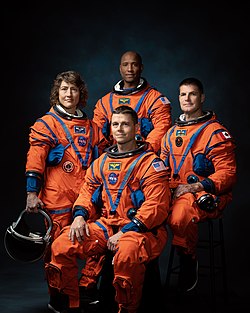
Back أرتيمس 2 Arabic আর্টেমিস ২ Bengali/Bangla Artemis II Catalan Artemis II Czech Artemis 2 German Artemis 2 Spanish Artemis 2 Estonian Artemis 2 Basque آرتمیس ۲ Persian Artemis II Finnish
 The Orion spacecraft and its European Service Module for the Artemis II mission being prepared for launch in March 2025 | |
| Names |
|
|---|---|
| Mission type | Crewed lunar flyby |
| Operator | NASA |
| Mission duration | 10 days (planned) |
| Spacecraft properties | |
| Spacecraft | Orion CM-003 |
| Crew | |
| Crew size | 4 |
| Members | |
| Start of mission | |
| Launch date | NET April 2026 |
| Rocket | Space Launch System Block 1 |
| Launch site | Kennedy Space Center, LC-39B[1] |
| End of mission | |
| Recovered by | U.S. Navy (San Antonio-class amphibious transport dock) |
| Landing site | Pacific Ocean (planned) |
| Flyby of Moon | |
| Distance | 6,400 mi (10,300 km) (planned)[2] |
 Artemis II mission patch  Official crew portrait, clockwise from left: Koch, Glover, Hansen and Wiseman | |
Artemis II is a planned mission under the NASA-led Artemis program, set to be the second launch of the Space Launch System (SLS) rocket and the first crewed flight of the Orion spacecraft. Scheduled to launch in early 2026, the mission will carry four astronauts on a free-return trajectory around the Moon and back to Earth. It will be the first crewed mission to venture beyond low Earth orbit and travel to the Moon since Apollo 17 in 1972.
Initially designated as Exploration Mission-2 (EM-2), the mission was originally planned to retrieve samples from a captured asteroid as part of the now-canceled Asteroid Redirect Mission. It was later renamed following the establishment of the Artemis program.
- ^ Hill, Bill (March 2012). "Exploration Systems Development Status" (PDF). NASA Advisory Council. Archived from the original on 11 February 2017. Retrieved 21 July 2012.
 This article incorporates text from this source, which is in the public domain.
This article incorporates text from this source, which is in the public domain.
- ^ Hambleton, Kathryn (27 August 2018). "First Flight With Crew Important Step on Long-Term Return to Moon". NASA. Archived from the original on 30 August 2018. Retrieved 6 April 2023.
© MMXXIII Rich X Search. We shall prevail. All rights reserved. Rich X Search